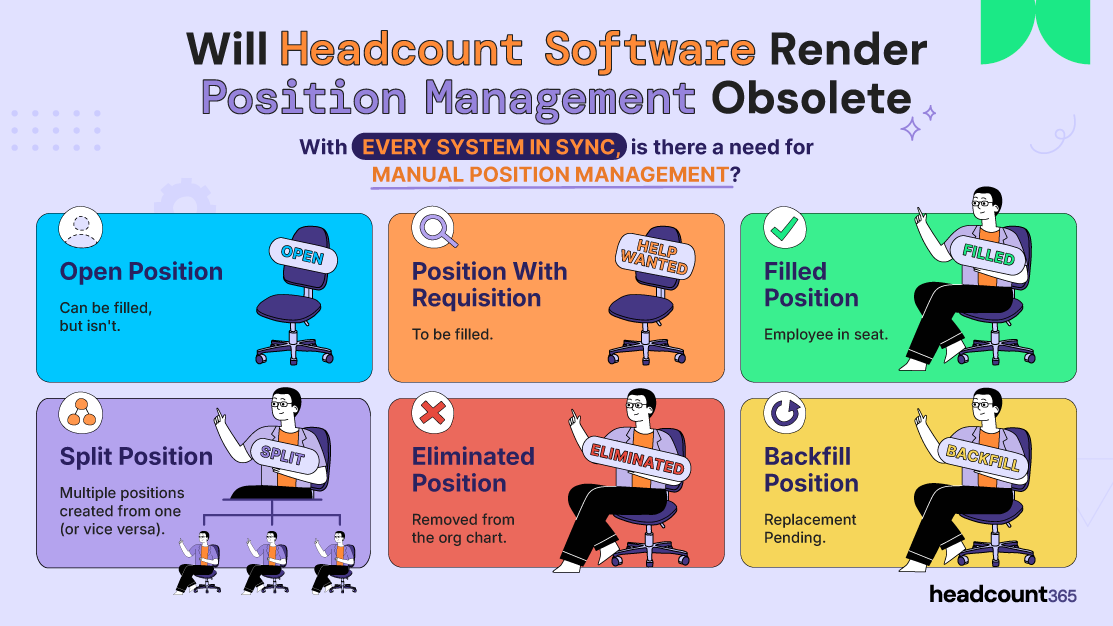Does Headcount Software Render Position Management Obsolete?
Table of Contents
Position Management is Broken
Most companies don’t actually know how many people they should be employing at full capacity.
What sounds like a basic question — “How many seats are in the org chart?” — is often answered with stale spreadsheets, misaligned systems, and bloated position counts. Finance thinks there are 600 roles, Recruiting is working from a plan of 520, and HR shows 580 — including roles that were re-org’d, duplicated, or never removed after promotions or transfers.
At best, position management is working behind the scenes — barely holding it all together. At worst, there’s no strategic initiative around how many positions the company should have. And that’s where real damage happens: untracked growth, over-hiring, budgeting blind spots, and massive OPEX variance that eats into profitability.
Position Management vs. Headcount Management
Position management is not the same as headcount management.
Position management defines the number of seats in the company — the organizational design, the budget, the strategic workforce plan.
Headcount management is the operational process of filling those seats — hiring, backfilling, tracking progress against plan.
The problem is, most companies never actually get position management right. Instead of a unified system of record for what should exist, they rely on siloed ledgers that constantly fall out of sync with reality. What’s supposed to be a foundational tool for revenue forecasting and cost control turns into a guessing game.
How Manual Position Management Breaks Down
Manual position management depends on someone — usually in People Ops or Recruiting — owning and maintaining the “truth” about how many positions exist. And no matter how skilled that person is, the model is always fighting entropy. Here’s why:
New positions get added outside of formal approval processes
Hiring managers submit backfills as net-new requests
Roles get split or merged without a corresponding update to the plan
Promotions and internal transfers generate additional reqs that aren’t tied to the original position
Annual hiring plans add roles in bulk — but they aren’t reconciled as plans change
Re-orgs and acquisitions introduce structural chaos that spreadsheets can’t adapt to
The result? No one — not Recruiting, not Finance, not leadership — can say with confidence how many positions exist, how many are approved, or how many are actually aligned with company goals.
The Paradigm Shift: What Software Makes Possible
A new generation of headcount software instantly reports on every headcount, across all three systems without the need to reconcile spreadsheets, systems or org charts. Instead of maintaining a static ledger of “what should be,” software enables companies to operate from what is, in real time, without manual reconciliation.
Here’s what changes:
Real-Time Accuracy
At any point, the company can know exactly how many positions exist — and how that number breaks down by department, level, or status — without a person doing any work.Automated Lifecycle Tracking
Splits, merges, backfills, freezes, and reforecasts are captured automatically. Each action is logged with context, so there’s no need to chase down what happened and why.Unified IDs
Every position, requisition and opening has a unique software-generated ID that tracks its history through re-orgs, rebrands, and budget cycles. It’s a living audit trail — not a spreadsheet snapshot.Instant Reference Points
Because software captures position counts over time, it becomes easy to compare past vs. present states — whether you're analyzing post-acquisition headcount or planning next quarter’s hiring surge.Real Time Budget Impact
Every dollar is instantly accounted for, with in-year calculations considering start date and annualized predictions for the next fiscal year.
This shift removes the need for human reconciliation. The system becomes the source of truth, and position management process no longer need to be “accounting” for positions.
Benefits of Eliminating Position Management
The benefits of this shift aren’t just operational — they’re financial and strategic:
Executives gain a reliable, real-time view of staffing vs. plan without having to reconcile stale data to a position system — improving cost discipline and eliminating surprises
Finance can budget and forecast based on accurate, timely position data — not outdated assumptions
People Ops can stop firefighting and start scenario planning — with position integrity built into every move
Recruiting can more effectively plan recruiting capacity against demand, and build a predictible service of recruiting
Hiring Leaders always knows what’s approved, what’s open, and how it ties back to the broader strategy
headcount365’s Automation May Forever Change Position Management
Position management isn’t going away — it’s evolving away from manual control systems based on spreadsheets and disconnected systems. The companies that win are those who treat positions as living objects — dynamic, trackable, and tightly integrated into business planning.
Learn more about headcount365’s automated position management system here
The evolution of position management comes from an evolution of how systems integrate. Traditional position management, is owned by one siloed system and reconciled on a periodic basis. With headcount365, all data flows into one system using real time integrations.
HRIS Integrations | Every existing employee & their current employment status, including reporting structure, department, cost center, and other position management related information
FP&A Integrations | A real time connection of all position information to the FP&A tool for financial tracking, particularly when budgets move between managers and cost centers
ATS Integrations | The status of every new hire automatically pulled from the ATS and synced with HR & FP&A so new position creation has a uniform process and controls
Software makes that possible. And once it’s in place, you don’t just manage headcount better — you run the business better.

